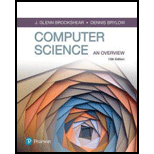
Explanation of Solution
Tree structure to store the genealogical history of a family:
The tree structure to store the genealogical history of a family is shown below:
The general structure for normal linked list and the genealogical
Each node in the linked list is represented by the
Then each node in the linked structure of genealogical is represented by the below ways
Operations performed by the given tree:
The operation performed by the given tree are insertion and searching operation.
Pointers associated with each node by using linked structure:
In the linked structure, the pointers associated with each node is given below:
- Parent pointer
- Spouse pointer
- Left child pointer
- Right child pointer
- Sibling pointer
The general linked list structure for pointers associated with each node is given below
Procedure to perform the above linked structure:
Procedure InsertOperation(Tree, data)
if(Tree is None)
set the root pointer to a new node containing value;
Tree...
Want to see the full answer?
Check out a sample textbook solution
Chapter 8 Solutions
Computer Science: An Overview (13th Edition) (What's New in Computer Science)
 Systems ArchitectureComputer ScienceISBN:9781305080195Author:Stephen D. BurdPublisher:Cengage LearningProgramming Logic & Design ComprehensiveComputer ScienceISBN:9781337669405Author:FARRELLPublisher:Cengage
Systems ArchitectureComputer ScienceISBN:9781305080195Author:Stephen D. BurdPublisher:Cengage LearningProgramming Logic & Design ComprehensiveComputer ScienceISBN:9781337669405Author:FARRELLPublisher:Cengage C++ for Engineers and ScientistsComputer ScienceISBN:9781133187844Author:Bronson, Gary J.Publisher:Course Technology Ptr
C++ for Engineers and ScientistsComputer ScienceISBN:9781133187844Author:Bronson, Gary J.Publisher:Course Technology Ptr
 Fundamentals of Information SystemsComputer ScienceISBN:9781305082168Author:Ralph Stair, George ReynoldsPublisher:Cengage Learning
Fundamentals of Information SystemsComputer ScienceISBN:9781305082168Author:Ralph Stair, George ReynoldsPublisher:Cengage Learning C++ Programming: From Problem Analysis to Program...Computer ScienceISBN:9781337102087Author:D. S. MalikPublisher:Cengage Learning
C++ Programming: From Problem Analysis to Program...Computer ScienceISBN:9781337102087Author:D. S. MalikPublisher:Cengage Learning





